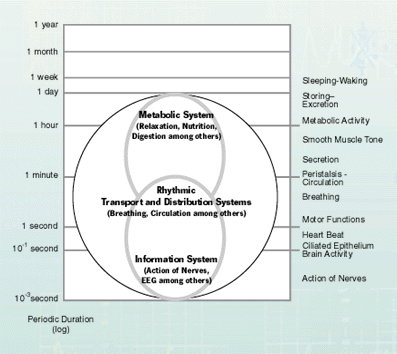|
The
shorter wave rhythms of the spectrum, however, (illustration 1, underneath
the day rhythm) are purely endogenous autonomic functional variations
which have no immediate link to the rhythms of the environment. Instead,
a special organisational principle shows itself in this area (illustration
6): So you find the highest frequency rhythmic processes in the
area of the nervous system. They serve here to change information,
i.e. for the absorption, transportation and processing of information
which is encoded into rhythmic signals. While the informational rhythms are strictly bound to highly differentiated spatial structures of the nervous system, the metabolic rhythms more or less concern all tissue and are spatially much less specified. The system of the rhythmic functions of transportation and distribution is the transition between these two completely different functional areas, especially with the rhythms of circulation and breathing. |
|
 |
|
|
|
| << >>
With kind permission of AAR EDITION © AAR EDITION INTERNATIONAL 2001 |
| B A S I C M U S I C M E D I C I N E R E S E A R C H |
|
The
Biological Fundamentals of the Digital Stress Management Chronobiological Aspects of Music Physiology continued |